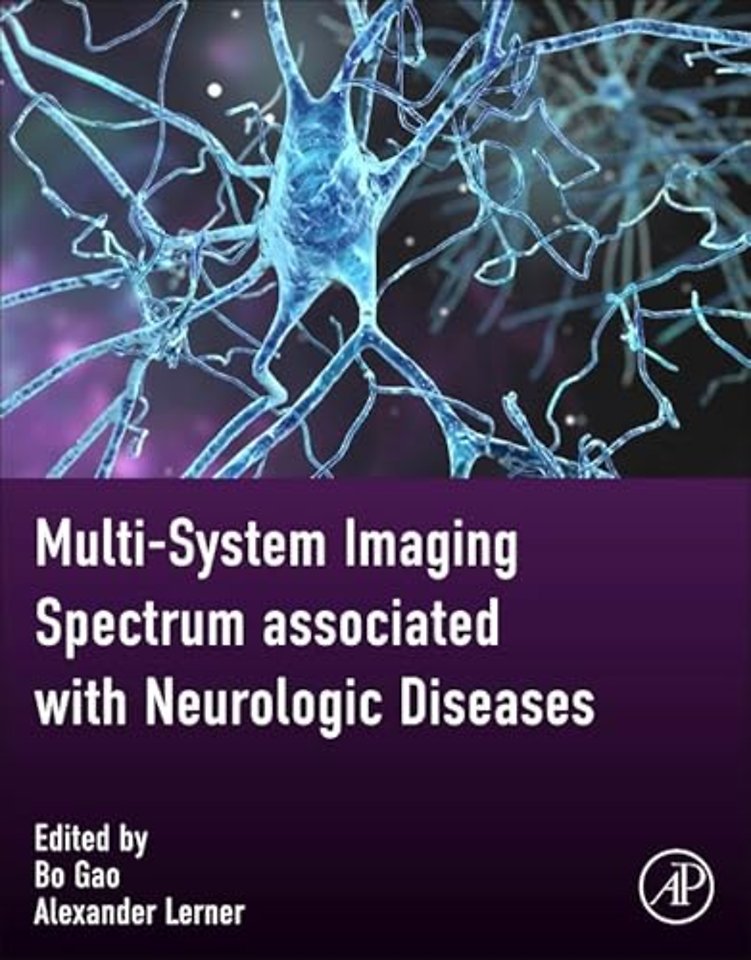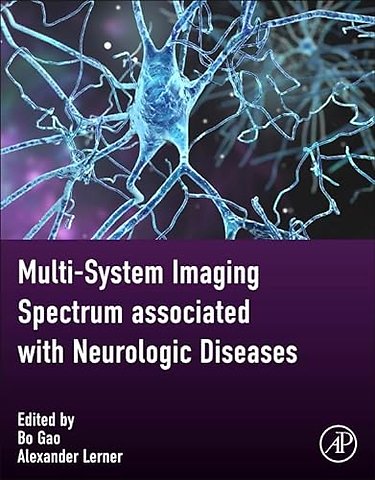Contributors<br>Biographies<br>Foreword I <br>Foreword II <br>Preface <br><br>1. Introduction<br>Bo Gao, Shi-ji Kan and Bihong T. Chen<br><br>1. Pathogenesis of multisystem diseases <br>2. Diagnostic algorithm of multisystem diseases <br>2.1 Overall approach in imaging diagnosis <br>2.2 Thinking process in imaging diagnosis <br>3. The role of imaging in diagnosing multisystem diseases <br>3.1 Overview <br>3.2 Pathophysiology <br>3.3 Central Nervous System involvement <br>3.4 Urinary system <br>3.5 Digestive system <br>3.6 Musculoskeletal system <br>3.7 Respiratory system <br>References <br><br>2. Nervous system<br>Heng Liu and Xiaoqing Liu<br><br>2.1 Multisystem effects of SturgeeWeber Syndrome<br>1. Introduction <br>2. Pathogenesis <br>3. Central nervous system <br>4. Skin <br>5. Eyes <br>6. Endocrine system <br>References<br><br>2.2 Multisystem effects of neurofibromatosis<br>1. Introduction <br>2. Pathology <br>3. Central nervous system <br>4. Musculoskeletal system <br>5. Respiratory system <br>6. Skin <br>References <br><br>2.3 Multisystem effects of tuberous sclerosis complex<br>1. Introduction <br>2. Pathogenesis <br>3. Central nervous system <br>4. Respiratory system <br>5. Circulatory system <br>6. Urinary system <br>7. Skin and oral cavity <br>References <br><br>2.4 Multisystem effects of von Hippel-Lindau syndrome<br>1. Introduction <br>2. Pathogenesis <br>3. Central nervous system <br>4. Digestive system <br>5. Urinary system <br>6. Endocrine system <br>7. Reproductive system <br>8. Eyes <br>9. Ears <br>References <br><br>3. Muscular system<br>Daniel Phung, Gordon Crews, Raymond Huang and Nasim Sheikh-Bahaei<br><br>1. Poliomyelitis <br>2. Scleroderma <br>3. Rhabdomyosarcoma <br>References <br><br>4. Respiratory system<br>Tian-le Wang<br><br>4.1 Aspergillosis<br>References <br>4.2 Langerhans cell histiocytosis<br>References <br>4.3 Metastatic tumor<br>References <br>4.4 Neurogenic pulmonary edema<br>References <br>4.5 Nocardia infection<br>References <br>4.6 Tuberculosis<br>References <br>4.7 Tuberous sclerosis complex<br>References <br><br>5. Cardiovascular system<br>Jing Wang and Teng Jin<br><br>5.1 Neurological complications of cardiac surgery<br>Jing Wang<br><br>1. Peripheral nerve injuries <br>2. Abnormal visual function <br>3. Cognitive dysfunctions <br>4. Heart transplantation <br>References <br><br>5.2 Neurologic complication of infective endocarditis<br>Jing Wang<br><br>1. Ischemic lesion <br>2. Cerebral microbleeds (CMBs) <br>3. Hemorrhagic lesions <br>4. Intracranial mycotic aneurysms <br>5. Brain abscess and meningitis <br>Further reading <br><br>5.3 Neurological complications of hypertension<br>Teng Jin<br><br>1. Aneurysmal subarachnoid hemorrhage <br>2. Hypertensive intracranial hemorrhage <br>3. Lacunar infarcts <br>4. Binswanger syndrome <br>References <br><br>5.4 Neurological complications of systemic vasculitis<br>Teng Jin<br><br>1. Bechet’s disease <br>2. Takayasu arteritis <br>3. Giant cell arteritis <br>4. Wegner’s granulomatosis <br>References <br><br>6. Digestive system<br>Peng Liu<br><br>1. Introduction <br>2. Hepatic encephalopathy <br>3. Acquired hepatocerebral degeneration <br>4. Pancreatic encephalopathy <br>5. Hepatic myelopathy <br>6. Wernicke encephalopathy <br>7. Inflammatory bowel disease CNS involvement <br>8. Wilson disease <br>9. Tuberous sclerosis <br>10. Multiple endocrine neoplasia type 1 <br>11. Von Hippel-Lindau disease <br>12. Hereditary hemorrhagic telangiectasia <br>13. Turcot syndrome <br>14. Neurofibromatosis type 1 <br>15. Gardner syndrome <br>16. IgG4-related diseases <br>17. Sarcoidosis <br>18. Behc¸et disease <br>19. Systemic sclerosis <br>20. Amyloidosis <br>References <br><br>7. Excretory system<br>Pinggui Lei and Bin Huang<br><br>1. Von Hippel-Lindau syndrome <br>2. Tuberous Sclerosis Complex <br>3. Behc¸et’s disease <br>4. Uremic encephalopathy <br>5. Polycystic kidneys disease <br>Further reading <br><br>8. Reproductive system<br>Xuntao Yin and Huiying Wu<br><br>1. Role of estrogen on neurological disorders <br>1.1 Estrogen in the brain <br>1.2 Estrogen and mood disorders <br>1.3 Estrogen and Alzheimer’s disease <br>1.4 Estrogen and Parkinson’s disease <br>1.5 Estrogen and multiple sclerosis <br>2. Paraneoplastic syndromes <br>2.1 Subacute cerebellar degeneration/cerebellar ataxia <br>2.2 Limbic encephalitis and anti-N-methyl-D-Aspartate receptor encephalitis <br>2.3 Opsoclonus-myoclonus syndrome <br>2.4 Paraneoplastic subacute sensory neuropathy <br>2.5 Sensorimotor neuropathy <br>2.6 Lamberteeaton myasthenic syndrome <br>2.7 Myasthenia gravis <br>3. AIDS <br>3.1 AIDS patients with CNS cryptococcosis <br>3.2 AIDS patients with CNS lymphoma <br>References <br><br>9. Skeletal system<br>Daniel Phung, Gordon Crews, Raymond Huang and Nasim Sheikh-Bahaei<br><br>1. Ankylosing spondylitis <br>2. Pigmented villonodular synovitis <br>3. Chordoma <br>4. Extradural meningioma <br>5. Cerebral fat emboli <br>6. Rheumatoid arthritis <br>7. Osteochondroma <br>References <br><br>10. Endocrine system<br>Raymond Huang, Daniel Phung, Gordon Crews and Nasim Sheikh-Bahaei<br><br>1. Background: pituitary adenoma <br>2. Prolactinoma <br>3. Acromegaly <br>4. Pituitary hyperplasia <br>5. Apoplexy/hemorrhagic adenoma <br>6. Thyroid-ophthalmopathy <br>7. DM and associated neurologic complications <br>References <br><br>11. Immune system<br>Gordon Crews, Alexander Lerner, Daniel Phung and Nasim Sheikh-Bahaei<br><br>1. Acute disseminated encephalomyelopathy <br>2. Multiple sclerosis <br>3. Neuromyelitis optica <br>4. Autoimmune encephalitis <br>5. Neurosarcoidosis <br>6. Systemic lupus erythematosus <br>7. Bell’s palsy <br>8. CNS vasculitis <br>References <br><br>12. Lymphatic system<br>Jing Yu<br><br>12.1 Sarcoidosis<br>Further reading <br>12.2 Lymphoma<br>Further reading <br>12.3 Leukemias<br>Further reading <br>12.4 POEMS syndrome<br>Further reading <br><br>13. Integumentary system<br>Xia Du<br><br>13.1 Neurofibromatosis<br>Further reading <br>13.2 Tuberous sclerosis<br>Further reading <br>13.3 SturgeeWeber syndrome<br>Further reading <br>13.4 Neurocutaneous melanosis<br>Further reading <br><br>Index

